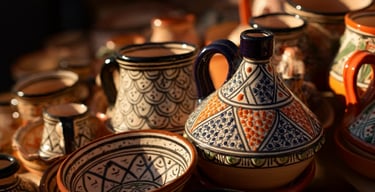Symbolism in Moroccan Pottery Designs
CULTURE & HERITAGE


Moroccan pottery is renowned for its intricate designs, vibrant colors, and rich cultural significance. Beyond their aesthetic appeal, the motifs and symbols adorning these ceramics hold deep meaning, often reflecting centuries-old traditions and beliefs. The fusion of geometric patterns, floral designs, and religious symbols creates a visual language that speaks to Morocco’s diverse history and spiritual heritage.
Geometric Shapes: Harmony and Balance
One of the most common features in Moroccan pottery is the use of geometric patterns. These intricate designs—composed of shapes like triangles, squares, and hexagons—are not just decorative; they carry deep symbolism. In Islamic art, geometric shapes are often used to represent the infinite nature of the universe. The repeated patterns emphasize the idea of unity and order within the chaos of life. They also reflect the Islamic belief in the omnipresence of Allah, with no need for figurative representations.
Geometric patterns in Moroccan pottery often embody a sense of balance and harmony, achieved through precise measurements and careful arrangements of shapes. These designs are a reminder of the intricate connections between the material and spiritual worlds, illustrating how the two can coexist in perfect equilibrium.
Floral Patterns: Nature’s Bounty and Fertility
Floral motifs are another prominent feature of Moroccan pottery. These patterns are often stylized, with flowers, vines, and leaves depicted in a symmetrical or flowing manner. Floral designs symbolize nature’s beauty, the cycles of life, and the fertility of the land.
In Moroccan culture, nature has always been intertwined with daily life, as agriculture plays a significant role in sustaining communities. The inclusion of flowers and plants in pottery designs reflects a reverence for the land’s abundance and fertility, often representing hope for prosperous seasons. The fluidity of these motifs also contrasts with the rigid structure of geometric patterns, adding an element of organic movement to the pottery’s design.
Religious Symbols: Spiritual Connection and Protection
Religion is a cornerstone of Moroccan culture, and its influence is evident in pottery designs as well. The most common religious symbols found in Moroccan ceramics include stars, crescent moons, and the Hand of Fatima (Hamsa). These motifs are used to evoke spirituality and offer protection.
The five-pointed star, known as the Seal of Solomon, is frequently seen in Moroccan art and symbolizes wisdom and divine protection. The crescent moon and star, often associated with Islam, represent guidance and the light of faith. Another powerful symbol is the Hamsa, a hand-shaped motif believed to ward off evil and bring good fortune. This symbol is deeply embedded in Moroccan pottery, offering spiritual protection to the owner.
Color Symbolism: Vibrancy and Meaning
Colors play a significant role in the symbolism of Moroccan pottery. The vibrant blues, greens, reds, and yellows that adorn these ceramics are not just for visual appeal—they carry symbolic meanings as well. Blue, often associated with the sky and sea, represents spirituality and protection against the evil eye. Green is connected to Islam and is the color of paradise, symbolizing life and renewal. Red signifies strength, passion, and vitality, while yellow represents the sun, light, and joy.
Conclusion
Moroccan pottery is more than just a visual art form; it is a medium that conveys deep cultural, spiritual, and symbolic meaning. Through geometric shapes, floral patterns, religious symbols, and vibrant colors, Moroccan artisans communicate a rich tapestry of life’s interconnectedness. Each design tells a story, whether it’s about balance and harmony, the beauty of nature, or spiritual protection. The symbolism in Moroccan pottery not only reflects the artistic creativity of its makers but also offers a glimpse into the values and beliefs that have shaped Moroccan culture for centuries.
